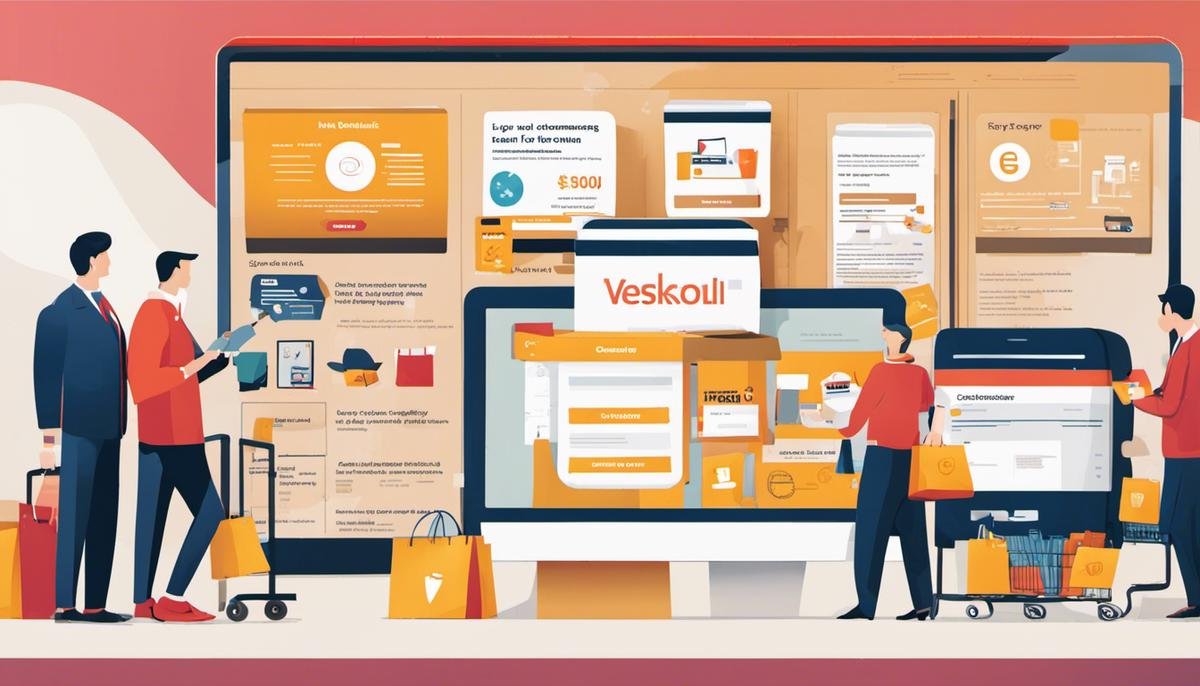In our rapidly evolving digital world, a personalized approach to e-commerce has become the new norm, giving businesses a competitive edge while dramatically enhancing the customer’s online shopping experience. Across today’s vast marketplaces, consumer preferences and behaviors are meticulously gathered and analyzed, tailoring the buying journey to meet individual needs. This deep dive into e-commerce personalization will unravel the core concepts, from data collection and customer segmentation to targeted marketing strategies. We will explore the many advantages for businesses and the consequential benefits to customers, providing real-world examples and compelling statistics along the way. Furthermore, we will delve into the latest trends and emerging technologies such as AI, machine learning, and predictive analytics that are innovating our approach to e-commerce. Finally, we will give practical guidance on implementing personalization strategies, ensuring you have the knowledge to make an informed decision on your business strategy.
Understanding E-commerce Personalization
Understanding E-commerce Personalization
E-commerce personalization refers to the practice of creating personalized interactions and experiences on ecommerce websites by dynamically displaying content, product recommendations, and specific offers based on previous actions, browsed behavior, demographic information, and other personal data.
These personalized interactions can be dramatically higher in relevance to the visitor compared to standard “one-size-fits-all” experiences, leading to increased levels of engagement, more repeat business, higher average order value, higher overall ecommerce sales, and improved customer retention.
The first step in e-commerce personalization is data collection. Online marketers obtain information on customer behaviors and preferences through various sources such as website analytics, purchase histories, customer feedback, social media profiles and interactions, and other online behavior. Modern businesses use sophisticated tools and software to gather and analyze this data, allowing them to understand a customer’s behavior in real time, track changes in their preferences, and predict future behavior.
The Role of Customer Segmentation in E-commerce Personalization
Customer segmentation is a critical factor in e-commerce personalization. It refers to the process of dividing an e-commerce website’s overall customer base into smaller groups, or segments, based on shared characteristics. These segments can be based on demographics (like age, gender, location), browsing behavior, purchase history, and others. E-commerce businesses use the segmentation data to send targeted communication to different segments, resulting in more effective marketing.
For example, a business might have a segment for customers who frequently purchase a particular product. When the business plans to release an updated version of the product, they can target marketing efforts specifically towards this segment, increasing the likelihood of purchases. Understanding the unique needs and preferences of each segment allows ecommerce businesses to personalize their offers and messages, which can lead to higher conversion rates and improved customer loyalty.
Exploring Personalization in E-commerce Marketing
Personalization in e-commerce involves tailor-made marketing strategies that target specific parts of the customer base. These strategies, encompassing personalized email marketing, retargeting campaigns, personalized product recommendations, and dynamic website content, aim at delivering messages that cater directly to the customer’s needs and preferences.
Email marketing becomes personalized when each email contains content tailored to suit the individual customer’s needs and preferences, making the message more relevant and engaging. Retargeting campaigns, alternatively, show ads to users who have previously interacted with the website, thereby creating a sense of familiarity.
Furthermore, e-commerce also presents customers with personalized product recommendations based on an individual’s browsing history, past purchases, and even behavioral data, making the shopping experience more personalized and intriguing.

Benefits of E-commerce Personalization for Businesses
Boosting Customer Satisfaction with Personalization in E-commerce
E-commerce personalization puts a strong emphasis on providing an individualized experience to boost online shopping engagement. Consumers have demonstrated a propensity for personalized over generic offers, with data indicating about 91% of consumers tend to lean towards brands that offer personalized experiences and recommendations. Accordingly, e-commerce businesses that implement such personalization enjoy considerable increases in customer satisfaction. This is because each shopping experience is uniquely crafted, taking into account each customer’s preferences and purchase history, making each shopping experience distinctive and memorable.
Boosting Conversion Rates with Personalization
E-commerce personalization also plays a pivotal role in enhancing conversion rates. Using browsing and purchasing data, businesses can provide customers with recommendations tailored to their tastes, thereby increasing the likelihood of purchase. Personalization has been shown to produce a 20% increase in sales, while reducing the acquisition costs by as much as 50%.
Leveraging Personalization for ROI
Keeping in line with the increased conversion rates, return on investment (ROI) is another compelling advantage of e-commerce personalization. According to a study done by Barilliance, personalizing online stores can drastically enhance ROI as it tends to increase average order value. For instance, businesses that allow customers to personalize their products can charge 20% more compared to those that sell standard items. This incrementally adds up to the revenues and thus elevates ROI.
Personalization=Brand Distinction
In the saturated world of online shopping, having a personalized approach can make a brand stand out among its competitors. Online shoppers appreciate attention to detail and the feeling of being “special”; personalization in e-commerce provides just that. In a survey conducted by Segment, 44% of consumers indicated they would likely return as repeat buyers after a personalized shopping experience. This illustrates how personalization can doubtlessly differentiate a brand, creating loyal customers who continually engage with the brand due to the personal touch they receive.
Real-World Examples of Personalization Benefits
World-renowned businesses have also demonstrated the power of e-commerce personalization. Fashion retailer ASOS, for example, uses personalization to suggest items to their customers. They use machine learning to understand customers’ preferences and buying behaviors, which has seen their sales skyrocket. Similarly, retail giant Amazon reported that 35% of all its sales come from its personalized recommendation engine.
In recent times, the successful implementation of e-commerce personalization has demonstrated extensive benefits for businesses. These advantages include boosting customer satisfaction, amping up conversion rates, escalating return on investment, and helping brands shine brighter than their competitors. The business landscape is witnessing a massive shift towards a more personalized approach, and those leading the charge in this direction stand to gather substantial rewards.

Importance of E-commerce Personalization for Customers
Deciphering E-commerce Personalization: The Customer’s Viewpoint
E-commerce personalization is the process of tailoring shopping experiences to engage customers more meaningfully, resulting in higher conversion rates and enhanced customer gratification. Its implementation typically involves using customer data and futuristic technologies to furnish more pertinent product suggestions, promotional messages and overall shopping ambiance.
For shoppers, personalization plays a significant role as it enriches their buying journey. They get product suggestions tailored to their distinct tastes, behaviors, and past procurement, thereby increasing their chances of finding exactly what they require or stumbling upon exciting new products that pique their interest.
Furthermore, with the digital market flooded with an overwhelming range of choices, personalization curates and condenses the wide selection, offering only the most relevant products. This feature enables quicker, more straightforward decision-making, and reduces the risk of customers feeling swamped or exiting the site altogether.
How Personalization Enhances User Experience
E-commerce personalization enhances the user experience by improving the relevancy of what customers see when they visit online shops. Through tailored product suggestions, personalized search results, and customized content, businesses are able to offer targeted solutions that fulfill their customers’ specific needs.
Instead of making customers scroll through irrelevant options, businesses can use personalization to direct them straight to the items they desire. Such an approach reduces friction in the purchasing process, resulting in a better, smoother user experience that can encourage repeat visits and future purchases.
The Role of Personalization in Customer Loyalty and Satisfaction
Personalization goes a long way in boosting customer loyalty and satisfaction as well. When customers are consistently provided with personalized experiences that value their unique interests and needs, they’re more likely to develop a sense of loyalty towards the brand. They feel understood and appreciated, and this feeling of personal connection can significantly heighten their overall satisfaction with the shopping experience.
Loyal customers are more likely to return to the store, make repeat purchases, and become brand ambassadors who share their positive experiences with others. Therefore, investing in e-commerce personalization can have long-term payoffs in terms of customer retention, brand reputation, and overall business growth.
Exploring Customer Expectations for Personalized E-commerce Experiences
In the rapidly evolving paradigm of today’s digital marketplace, customer expectations for personalized e-commerce experiences are constantly on the rise. Many consumers are now looking to businesses for an understanding of their unique preferences, along with an aptly customized shopping experience.
Indeed, recent research studies support the claim that personalization has the potential to greatly impact a customer’s perception of the brand and significantly influence their buying choices. For instance, according to an Infosys study, a staggering 86% of consumers admit that personalization is a decisive factor when they make purchasing decisions.
Fascinatingly, the majority of customers do not mind sharing their personal data if it promises to enhance their overall shopping journey. As per an Accenture study, 83% of consumers are ready to share their information in exchange for a tailor-made experience. This is a clear indication of the immense value customers attribute to personalization, emphasizing its pivotal role in designing fruitful e-commerce strategies.

Trends and Technologies in E-commerce Personalization
Untangling the Trends in E-commerce Personalization
On the cutting edge of e-commerce personalization trends is the widespread integration of artificial intelligence (AI) and machine learning techniques. These advanced technological aids enable e-commerce businesses to collect and process a plethora of data in real-time, thereby affording them the opportunity to meticulously craft marketing strategies aimed at catering to the unique preferences and shopping patterns of individual customers.
Furthermore, another noteworthy advancement in this realm is the use of predictive analytics. This state-of-the-art methodology relies on both historical and real-time data to extrapolate potential future consumer behavior. Employing predictive analytics can help e-commerce businesses predict the potential interests of consumers, based on their past purchase history or browsing activity.
Innovations in AI and Machine Learning
Recent innovations in AI and machine learning have resulted in a more intuitive and personalized shopping experience for e-commerce customers. AI tools can automatically adjust the products displayed to an individual consumer based on their previous interactions with the website. Machine learning algorithms can also analyze a consumer’s engagement with email marketing campaigns and adapt future emails to enhance their effectiveness.
Emerging Technologies in Predictive Analytics
Emerging technologies in predictive analytics optimize the e-commerce personalization process through various methods such as analyzing customer feedback, studying repeated patterns, and monitoring individual consumer preferences. For instance, if a customer leaves a positive review for a product, predictive analytics tools can suggest similar items for their next visit.
Advantages of E-commerce Personalization
E-commerce personalization technologies can provide several benefits for both consumers and businesses. Consumers enjoy a more personalized and efficient shopping experience, increasing their satisfaction levels and likelihood to make a purchase. For businesses, personalization techniques can lead to higher conversion rates, increased customer loyalty, and higher overall sales.
The Evolution and Future of E-commerce Personalization
As we delve into the future of e-commerce personalization, we see a rapidly evolving landscape driven by innovation and new technologies. These sophisticated changes come in the form of Artificial Intelligence (AI) and machine learning advancements that are expected to make marketing campaigns become more personalized than ever before. Tailored messages based on individual consumer behavior and preferences are anticipated to be the norm. Add to this the growth of predictive analytics, and businesses will not only understand but also anticipate their customers’ future needs, resulting in more dynamic and proactive marketing endeavors.

Implementing E-commerce Personalization
Decoding E-commerce Personalization
To understand e-commerce personalization, it’s essential to realize that it’s all about providing an online shopping experience that’s individually tailored for each customer. To achieve this, businesses track user behavior, gather data, understand their preferences, and use this information to deliver more targeted product suggestions, advertisements, and content. The ultimate goal of these personalized approaches is to elevate the customer experience, encourage long-lasting customer engagement and loyalty, and, in turn, boost sales.
Benefits of Implementing E-commerce Personalization
Implementing e-commerce personalization comes with a raft of benefits. For one, it improves the customer experience; users are likely to appreciate a more relevant and personalized shopping journey, reducing bounce rates and increasing conversion rates, order values, and customer retention. For small businesses, it helps level the playing field – despite lacking the budget of significant players, a well-executed personalization strategy can deliver notable ROI.
Best Practices in E-commerce Personalization
For a personalization strategy to be effective, certain best practices should be followed. First and foremost, the customer’s privacy should be respected at all times. Personalization should be built on trust; taking care to only use the data that customers willingly provide and to be transparent with how their data is being used.
Next, make sure the personalization is actually relevant. There is such a thing as over-personalizing, where product recommendations and content become so narrow, they restrict the customer’s discovery of new products. Constantly testing and refining your strategies is a crucial step in the personalization process, as is a comprehensive understanding of your target market.
Last, integrate your personalization efforts across all channels. Consistency is key; a customer should have the same personalized experience whether they’re browsing on a desktop, mobile, or visiting a physical store, if applicable.
Common Mistakes to Avoid
Mistakes in personalization strategies can damage your brand image, customer loyalty, and overall sales. One common mistake is to rely too heavily on historical data, which does not account for changes in a customer’s preferences. Similarly, both over-personalization and under-personalization can be damaging; finding the right balance is crucial.
Another common error is launching a full-scale personalization program all at once. Instead, start small, test, refine, learn, and iterate. This not only saves substantial resources but allows your team to adapt and become well-versed in personalization over time.
Steps to Implement E-commerce Personalization
Regardless of the size of a business or its available budget, the first step in implementing a personalization strategy should be data collection, which might involve tracking on-site behavior or gathering demographic data.
Following this, businesses need to harness this data to build customer segments and personas. These will allow for more targeted, relevant personalization moving forward.
Next comes the implementation of personalization through tools and software. There are many available, some boasting AI capabilities, A/B testing, and analytics.
Last, don’t forget to measure your results and adjust your strategies as necessary. Key metrics might include conversion rate, customer lifetime value, or user engagement.
Conclusion
While implementing e-commerce personalization strategies may seem daunting initially, the potential benefits make it a worthy pursuit. With attention to best practices, a proactive approach to avoiding common pitfalls, and a robust plan for implementation, businesses of any size can leverage personalization to their advantage.

Through understanding, implementing, and evolving with e-commerce personalization, businesses have the potential to carve out a significant competitive advantage, not only improving their bottom line but also creating more authentic relationships with customers. As we’ve ascertained, this level of customization carries a dual-edged benefit. For businesses, it raises customer satisfaction, conversion rates, and ROI. From the customer’s perspective, it provides a refined shopping experience that caters explicitly to their preferences, boosting loyalty and overall satisfaction. As we strive to keep a pulse on the latest trends and technologies, we must embrace the tools at our disposal, such as AI, machine learning, and predictive analytics, in refining and improving our personalization approaches. And with diligent implementation guided by best practices, businesses of any size can successfully establish a robust personalization system.




